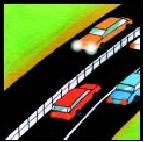Planning, design, operation and use of the road network
- Conditions of entry and exit of vehicles and road users to the road network
- Funding and resource allocation
- Institutional management functions
- Interventions
- Legislation
- Monitoring and evaluation
- Multi-sectoral co-ordination
- Promotion
- Recovery and rehabilitation of crash victims from the road network
- Research and development and knowledge transfer
- Results
- Results focus
- The evolution of road safety management for results
- The road safety management system
- The road safety management system
Planning, design, operation and use of the road network
Safety conscious network planning involves classifying roads and setting speed limits to match road function and separating out motorized from non-motorized traffic, wherever possible.
| Median barrier implementation in Sweden Some 38% of traffic flow on rural roads with a speed limit of 70km/h or greater is separated by median barrier. More than 3,500 kms of roads have separated traffic flows and 1,500 kms of these have 2+1 barriers. |
|
Proactive design involves adjusting the design and layout of the road and road networks such that they are 'self explanatory' to minimize error and to provide crash protection if an error is made. This includes self-explanatory road layouts, provision for pedestrians and cyclists, area-wide speed reduction and traffic calming, provision of crash-protective roadside objects and introducing safety impact assessment, audit and inspection (See iRAP and EuroRAP). Low-cost/high-return measures provide remedial action at specific sites, along stretches of road or on an area-wide basis. European countries report high benefits to cost of implementing road safety engineering. See Roads, Safety Ratings, Speeding, Pedestrians and Cyclists ERSO web texts for further information

